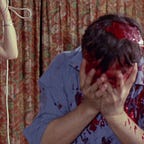The German Expressionist Film Warning Shadows
Celebrating its 100th anniversary this month.
Arthur Robison was born in Chicago in 1888, where his family would raise him for seven years before moving back to their native Germany. There, Arthur would grow up to study medicine and become a licensed practitioner. All the while, he was developing the acting bug. This led him to return to America and join a German-American theater troupe.
In 1914, he returned to Germany after his father's passing, and there he would begin directing films, under the company of producer and movie star Lu Synd. From there, he would bounce around between Germany, Switzerland, and the United States, directing various films.
In October of 1923, he premiered a film in Germany which would come to be his most well-known, an Expressionist film under the title of Schatten, known in English as Warning Shadows. When it was made, both the Expressionist movement and the horror film were in their infancy. The film attempts to distinguish itself from others of the time, while also laying some groundwork for films of the future.
The main distinguishing feature of the film is its lack of title cards, opting to let the visuals tell the whole story. This is an excellent opportunity for a filmmaker to let his or her imagination run wild and conjure up some neat visuals, of which this film has a few.
The cast of characters are introduced via role call. They all march onto a stage and present themselves, until the giant shadow of a hand shrouds them in the dark. The characters do not have proper names. They are referred to as Man, Woman, Youth, Three Gentlemen, Servants, Maid, and Traveling Entertainer.
If you’ve seen your share of silent films, you’ll recognize a few familiar faces. Among them are two principal cast members from F.W. Murnau’s Nosferatu. The Youth is played by Gustav von Wangenheim, who played Hutter, the stand-in for Jonathan Harker in Nosferatu.
The Traveling Entertainer is played by Alexander Granach, who played Knock, Murnau’s Renfield stand-in. He doesn’t wear as much grotesque make-up in this film, but still has an eccentricity about him, with his wild hair, short stature and high britches.
The main characters, Man and Woman, are married. The Woman invites a group of men over to their chateau for a party. Most of the men end up vying for her affections, at the behest of her husband. This includes von Wangenheim as the Youth, who's more suave and stoic here than he was as the foolish oaf Hutter.
The Traveling Entertainer performs shadow plays, where he casts a beam of light on the wall and animates some paper cut-out figures in front of the light.
These moments present some of the film's most inventive visuals, as the Entertainer manipulates light and shadow. At times, he would position the light in a way that united two shadows, in order to trick the Man into thinking the guests are getting handsy with his wife.
In another instance, the Entertainer uses some magic to move a huge overhead light, which shifts the guests' shadows from one side to the other, which makes them teleport to the other side of the table where they're sitting.
There's another cool shot where we think a character is staring down the hall at a big doorway, when it is actually the reflection of the doorway in a mirror.
There is some nifty experimentation going on, as was characteristic of the Expressionist movement, but unfortunately, these visual tricks are too few and far between. The overall experience of the film isn't very satisfying. The story is too basic, the setting is rather drab-looking, and much of it is shot very flat, like you're watching a stage play, save for one impressive pan backwards towards the end. It's no wonder why this one isn't as well-remembered as some of the other Expressionist classics.
The Expressionists were trying to elevate cinema to a purely visual form that would have a universal appeal, and it was an admirable attempt. F.W. Murnau would use many of the same techniques. He would make The Last Laugh the following year, which also didn't have intertitles. In Sunrise, Murnau's first Hollywood film, he would not designate a specific setting to his story, nor assign any names to his characters.
The Expressionists' dreams of a cinema that was purely visual would be dashed with the arrival of sound, as dialogue was placed at the forefront of film language. Although, there would still be attempts in the decades since to experiment with pure visual storytelling. Just to single out one example that I've written on in the past, John Parker's 1953 film Dementia.
Despite its historical value and public domain status, Warning Shadows is difficult to find online in high definition. The versions on YouTube are taken from a Kino DVD from 2006. The film has since been released on Blu-ray, remastered in 4K, but I would not recommend buying it. You're better off waiting for someone to upload a rip of it on YouTube.
